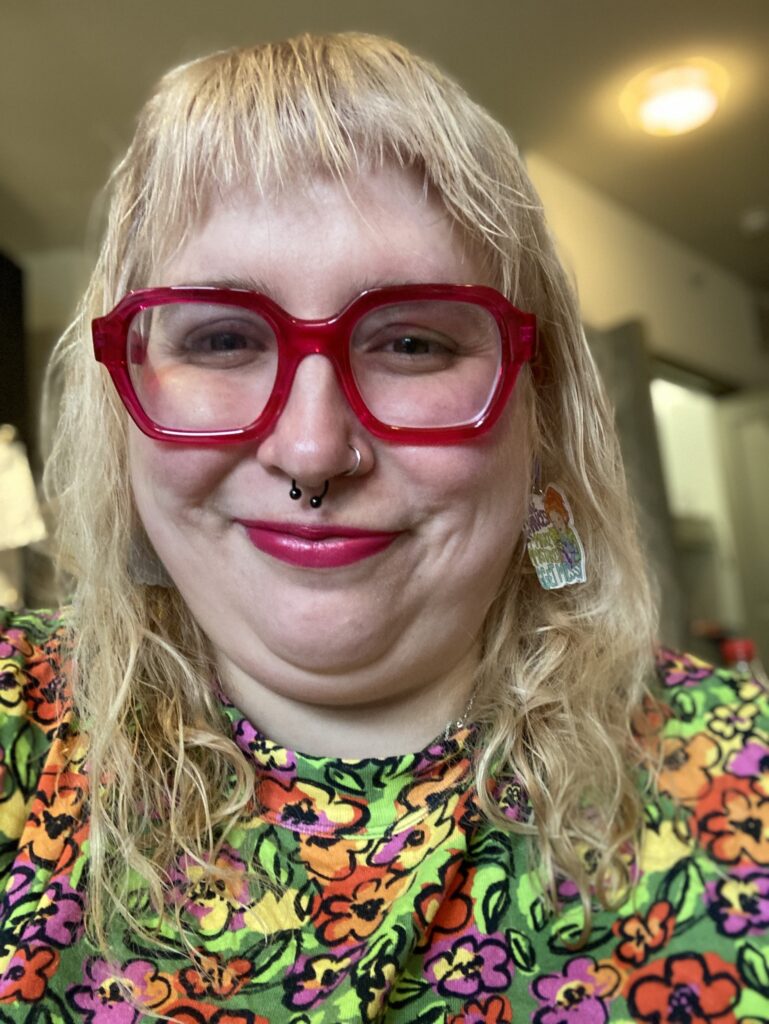
by Holly Genovese
I’m still not quite sure why I jumped at the opportunity to be a part of the Rebirth Garments fashion show: I’m a 5th year Ph.D. student, primarily embracing my status as a departmental ghost these days. But when I clicked on the website and saw Sky’s work, their manifesto, their vision for clothing and for the world, I couldn’t help but want to be a part of it. THE COLORS. THE PATTERNS.THE QUEERNESS. I also love clothes and the idea that I could have clothes designed for my disabled, fat, queer body that were also in line with my aesthetic choices was not just appealing, but magical, unbelievable. That I could wear a skirt that was stretchy and easy to put on but was also glittery and striped and polka dotted and yellow and pink and seemed to expand to contain me, all of me, all of my selves, my lives. I could wear a mini cape, yellow and pink, without fear of tripping, of being made uncomfortable by the fabric, of overheating as my body refuses to regulate temperature.
Once accepted, I was both excited and terrified: terrified that I wasn’t queer enough, disabled enough, mad enough to be part of the show. I don’t pass for straight a lot these days, but there is still that voice in my head telling me that I just don’t try hard enough, that I don’t work hard enough, that i am not disabled enough.. And if my neurodivergence isn’t a disability but a difference, then who am I to take part of this space? These are intrusive thoughts that I face regularly: I am not sick enough, mad enough, disabled enough, queer enough, autistic enough, fat enough for this beautiful queer/crip world that we are creating.
But to complete the interview, I had to face these questions head on and embrace myself: my vulnerabilities, the vulnerabilities that I decided to showcase. My favorite colors, my favorite patterns, my love of capes and whimsy, my love and terror of dancing in public over a decade after my dance practice was stopped by my knees and my ankles and my confidence. I imagined clothes that suited me perfectly, that showcased what I love about myself: my whimsy, my weirdness, my colors, my glitter. Clothes that didn’t overtly sexualize the parts of me that are often sexualized but also didn’t hide me: my personality, my vibrance, the sliver of belly visible between my top and skirt.
But the show, and the space we imagined/created/made exist, allowed for me to be present fully. My earplugs weren’t weird and in fact perfectly matched my handmade moon earrings. It didn’t matter that I needed to cover my ears when the music was loud. It didn’t matter that I stim when I’m nervous, because stimming is dancing is beauty is what we created together. It didn’t matter that my fatigue (and my knee and my medications) made it difficult for me to stand during the entire performance, because we were asked if we needed chairs. We were asked what would make us more comfortable. And after swishing across the floor in my multi patterned hot pink and yellow glitter skirt, when I started to panic, sky and my fellow models danced with me, held me, made me feel at home dancing, modeling, and wearing the clothes that, as Dr. Kafer wrote in an email to us, we “imagined into existence.” Because after all, that’s what the night was about. Imagining a different world into existence, one in which our queer/crip selves could exist fully and openly and loudly, decorating our mobility aids and matching our ear plugs to our outfits, dancing as stimming as jumping as walking as falling as sitting as being present. As operating on crip time, on queer time, on our time. Our disabilities, our queerness, our being, our breathing is beautiful and there, in that time/space/room, we could be ourselves as clearly as we wanted. Even in Texas, as our rights and the rights of trans people and drag queens and educators and students are stripped away, that room was our creation, was full of possibility, was full of what the world can be. In “Radical Visibility: A QueerCrip Dress Reform Movement Manifesto,” Sky writes that.
“We, as QueerCrips, are living contradictions in a society that wants us dead” (26). Society may want us dead, but what we did at the fashion show was re-create the possibility of queer/ crip life.

Holly Genovese (they/them) is a non-binary neurodivergent Austin-based writer, artist, content creator, and very tired Ph.D. Candidate in American Studies at UT Austin. Their visual art is primarily collage, mixed media, and acrylics and they served as art director for the 2021 issue of PubLab and have shown their work at the Da-Vinci Art Alliance in Philadelphia. Their writing (poetry, criticism, and journalism) has been published all over the internet and you can find out more at holly-genovese.com.
